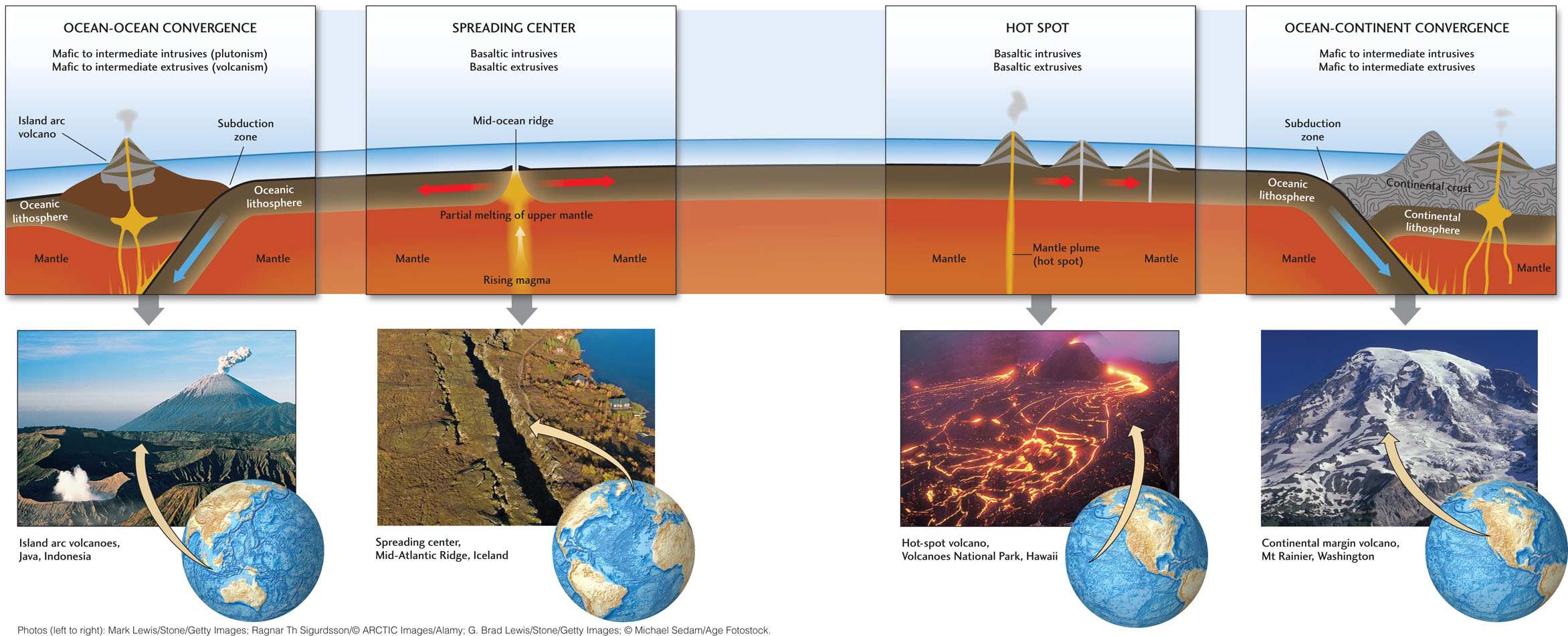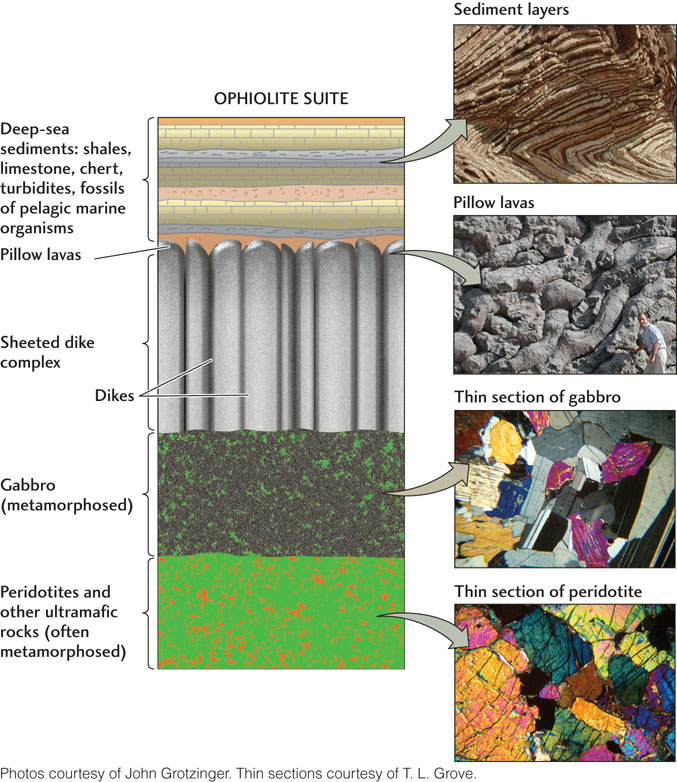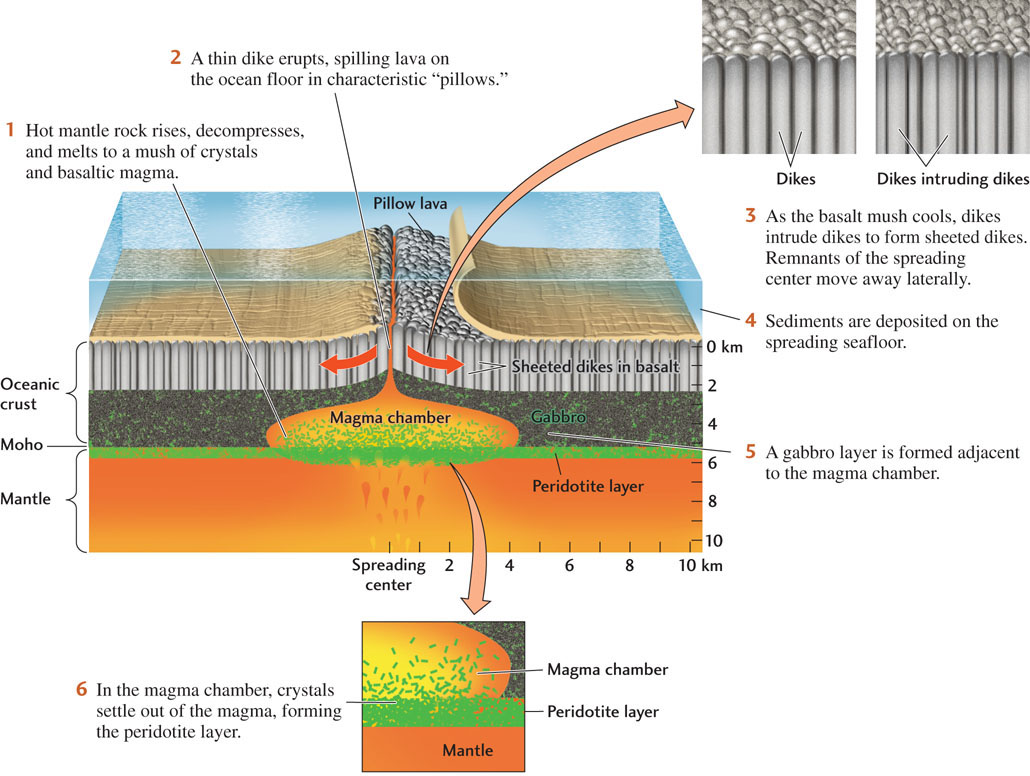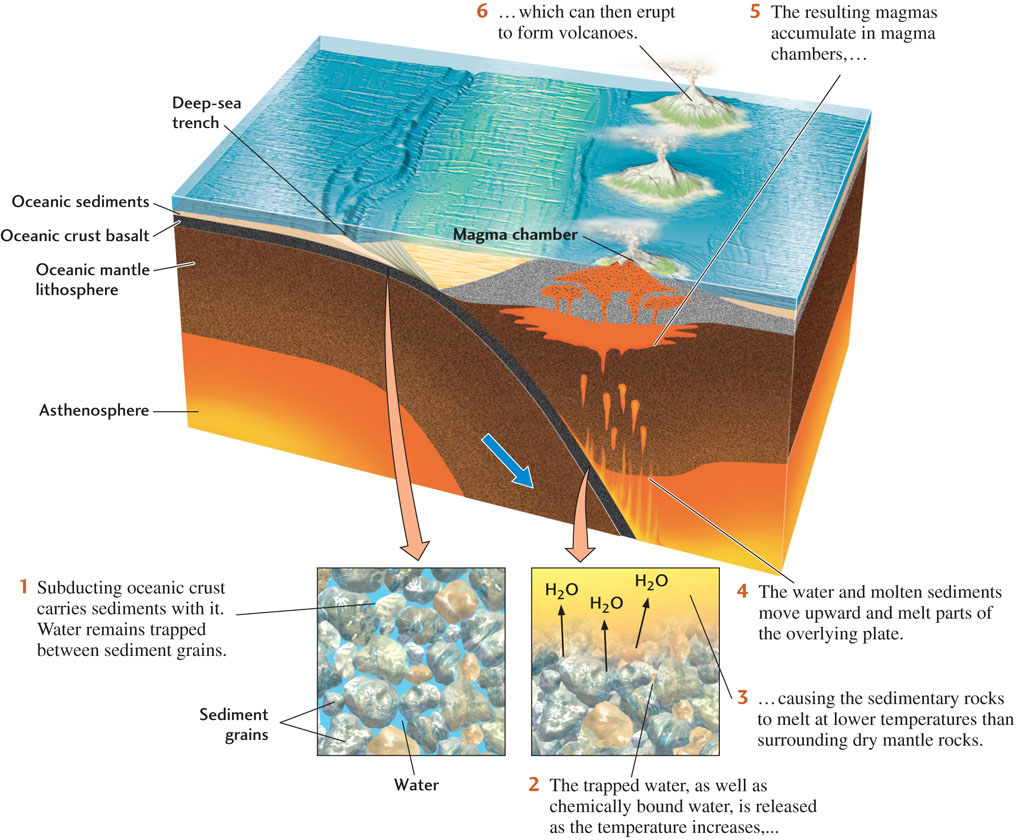Igneous Processes and Plate Tectonics
Geologists have observed that the facts and theories of igneous rock formation fit nicely into a framework based on plate tectonic theory. The geometry of plate movements is the link we need to tie tectonic activity and rock composition to igneous processes (Figure 4.13). Batholiths, for example, are found in the cores of many mountain ranges formed by the convergence of two plates. This observation implies a connection between pluton formation and the mountain-building process, and between both of those processes and plate movements. Similarly, our knowledge of the temperatures and pressures at which different kinds of rock melt gives us some idea of where melting takes place. For example, we know that mixtures of sedimentary rocks, because of their composition and water content, should melt at temperatures several hundred degrees below the melting point of basalt. This information leads us to predict that basalt will start to melt near the base of the crust in tectonically active regions of the upper mantle and that sedimentary rocks will melt at shallower depths.

Magma forms most abundantly in two plate tectonic settings: mid-ocean ridges, where two plates diverge and the seafloor spreads, and subduction zones, where one plate dives beneath another. Mantle plumes, though not associated with plate boundaries, also produce large amounts of magma.
106
Spreading Centers as Magma Factories
Most igneous rocks are formed at mid-ocean ridges by the process of seafloor spreading. Each year, approximately 19 km3 of basaltic magma is produced along the mid-ocean ridges in the process of seafloor spreading—a truly enormous volume. In comparison, all the active volcanoes along convergent plate boundaries (about 400) generate volcanic rock at a rate of less than 1 km3/year. Enough magma has erupted during seafloor spreading over the past 200 million years to create all of the present-day seafloor, which covers nearly two-thirds of Earth’s surface. Throughout the mid-ocean ridge network, decompression melting of mantle material that wells up along rising convection currents creates magma chambers below the ridge axis. These magmas are extruded as lavas and form new seafloor. At the same time, intrusions of gabbro are emplaced at depth.
Before the advent of plate tectonic theory, geologists were puzzled by unusual assemblages of rocks that were characteristic of the seafloor but were found on land. Known as ophiolite suites, these assemblages consist of deep-sea sediments, submarine basaltic lavas, and mafic igneous intrusions (Figure 4.14). Using data gathered from deep diving submarines, dredging, deep-sea drilling, and seismic exploration, geologists now explain these rocks as fragments of oceanic lithosphere that were transported by seafloor spreading and then raised above sea level and thrust onto a continent in a later episode of plate collision. On some of the more complete ophiolite suites preserved on land, we can literally walk across rocks that used to lie along the boundary between Earth’s oceanic crust and mantle.

107
How does seafloor spreading work? We can think of a spreading center as a huge factory that processes mantle material to produce oceanic crust. Figure 4.15 is a highly schematic and simplified representation of what may be happening, based in part on studies of ophiolite suites found on land and on information gleaned from deep-sea drilling and seismic profiling. Deep-sea drilling has penetrated to the gabbro layer of the seafloor, but not to the crust-mantle boundary below. Seismic profiling has found several small magma chambers similar to the one shown in Figure 4.15.

Input Material: Peridotite in the Mantle
The raw material fed into this magma factory comes from the convecting asthenosphere, in which the dominant rock type is peridotite. The mineral composition of the average peridotite in the mantle is chiefly olivine, with smaller amounts of pyroxene and garnet. Temperatures in the asthenosphere are hot enough to melt a small fraction of this peridotite (less than 1 percent), but not hot enough to generate substantial volumes of magma.
Process: Decompression Melting
Decompression melting is the process that generates great volumes of magma from peridotite at spreading centers. Recall that a decrease in pressure generally lowers a mineral’s melting temperature. As the plates pull apart, the partially molten peridotite is sucked inward and upward toward the spreading center. The decrease in pressure as the peridotite rises causes a large fraction of the rock (up to 15 percent) to melt. The buoyancy of the melt causes it to rise faster than the denser surrounding rock. This process separates the liquid rock from the remaining crystal mush to produce large volumes of magma.
108
Output Material: Oceanic Crust Plus Mantle Lithosphere
The peridotites subjected to this process do not melt evenly: the garnet and pyroxenes they contain melt at lower temperatures than the olivine. For this reason, the magma generated by decompression melting is not peridotitic in composition; rather, it is enriched in silica and iron. This basaltic melt forms a magma chamber below the mid-ocean ridge crest, where it separates into three layers (see Figure 4.15):
- 1. Some magma rises through the narrow cracks that open where the plates are separating and erupts into the ocean, forming the basaltic pillow lavas that cover the seafloor.
- 2. Some magma solidifies in the cracks as vertical, sheeted dikes of gabbro.
- 3. The remaining magma solidifies as massive intrusions of gabbro as the underlying magma chamber is pulled apart by seafloor spreading.
These igneous units—pillow lavas, sheeted dikes, and massive gabbros—are the basic layers of the crust that geologists have found throughout the world’s oceans.
Seafloor spreading results in another layer beneath this oceanic crust: the residual peridotite from which the basaltic magma was originally derived. Geologists consider this layer to be part of the mantle, but its composition is different from that of the convecting asthenosphere. In particular, the extraction of the basaltic melt makes the residual peridotite richer in olivine and stronger than ordinary mantle material. Geologists now believe it is this olivine-rich layer at the top of the mantle that gives the oceanic lithosphere its great rigidity.
Above the pillow lavas, a blanket of deep-sea sediment begins to cover the newly formed oceanic crust. As the seafloor spreads, these layers of sediment, pillow lavas, dikes, and gabbro are transported away from the mid-ocean ridge where this characteristic sequence of rocks is assembled, almost as if they were moving along a production line.
Subduction Zones as Magma Factories
Other types of magmas underlie regions where volcanoes are highly concentrated, such as the Andes of South America and the Aleutian Islands of Alaska. Both of these regions lie over subduction zones, which are major magma factories (Figure 4.16). They generate magmas of varying composition, depending on how much and what kinds of materials are subducted.

109
Where oceanic lithosphere is subducted beneath a continent, the resulting volcanoes and volcanic rocks form a volcanic mountain belt on the continent. The Andes, which mark the subduction of the Nazca Plate beneath South America, are one such mountain belt. Similarly, subduction of the small Juan de Fuca Plate beneath western North America has generated the Cascade Range, with its active volcanoes, in northern California, Oregon, and Washington. Where oceanic lithosphere is subducted beneath oceanic lithosphere, a deep-sea trench and a volcanic island arc are formed.
Input Material: A Mixed Bag
The variation in the chemical and mineral composition of magmas at subduction zones is a clue that the magma factories at convergent boundaries operate differently from those at spreading centers. The raw materials for these magma factories include mixtures of seafloor sediments, mixtures of basaltic oceanic crust and felsic continental crust, mantle peridotite, and water.
Process: Fluid-Induced Melting
The basic mechanism of magma formation at subduction zones is fluid-induced melting. The fluid involved is primarily water, which, as we have seen, lowers the melting temperature of rock. By the time oceanic lithosphere is subducted at a convergent plate boundary, a lot of water has been incorporated into its outer layers. We have already mentioned one of the processes responsible: hydrothermal activity during the formation of oceanic lithosphere. Some of the seawater that circulates through the crust near a spreading center reacts with basalt to form new hydrous minerals. In addition, as the lithosphere ages and is transported across the ocean basin, sediments containing water are deposited on its surface. The rocks formed from these sediments include shales, which contain large proportions of hydrous clay minerals. Some of these sediments get scraped off the subducting plate at the deep-sea trench, but much of this water-laden material is carried downward into the subduction zone.
110
As the lithospheric slab moves downward, it is subjected to increasing pressure. Water is squeezed out of the minerals in the outer layers of the descending crust and rises buoyantly into the mantle above the descending crust. At moderate depths of about 5 km, the temperature increases to about 150°C. Here, more water is released by metamorphic chemical reactions as basalt is converted to amphibolite, which is composed of amphibole and plagioclase feldspar (see Chapter 6). As other chemical reactions take place, additional water is released at depths ranging from 10 to 20 km. Finally, at depths greater than 100 km, the temperature increases to 1200°C–1500°C, and the subducted slab undergoes an additional metamorphic transition induced by the increased pressure. Amphibolite is converted to eclogite, which is composed of pyroxene and garnet (see Chapter 6). Here, the increase in both pressure and temperature in the subducting slab releases all of its remaining water in addition to other materials.
During subduction, the released water induces melting in the descending basalt-rich oceanic crust and in the overlying peridotite-rich mantle material. Most of the resulting mafic magma accumulates at the base of the crust of the overriding plate, and some of it intrudes into the crust to form magma chambers, resulting in the formation of volcanoes.
Output: Magmas of Varying Composition
The magmas produced by fluid-induced melting at subduction zones are essentially basaltic, although their composition is more variable than that of mid-ocean ridge basalts. The composition of these magmas is further altered during their residence in the crust. Within magma chambers, the process of fractional crystallization increases the magma’s silica content, producing eruptions of andesitic lavas. Where the overlying plate is continental, the heat from the magmas can melt the felsic rocks in the crust, forming magmas with an even higher silica content, such as dacitic and rhyolitic magmas. The contribution of lithospheric fluids to these magmas is suggested by the presence in the magmas of trace elements known to be present in oceanic crust and sediments.
111
Mantle Plumes as Magma Factories
Mantle plumes, like spreading centers, are sites of decompression melting, but they differ from spreading centers by forming within lithospheric plates rather than along the margins of plates. These plumes of hot mantle material rise from deep within Earth, possibly as deep as the core-mantle boundary. Mantle plumes that reach the surface, most of them far from plate boundaries, form the “hot spots” of Earth. At these locations, basaltic magmas produced by decompression melting of mantle material may erupt in huge outpourings to form islands, such as the Hawaiian Islands, or basalt plateaus, such as the Columbia Plateau in the Pacific Northwest of North America. Mantle plumes and hot spots are discussed in more detail in Chapter 12.